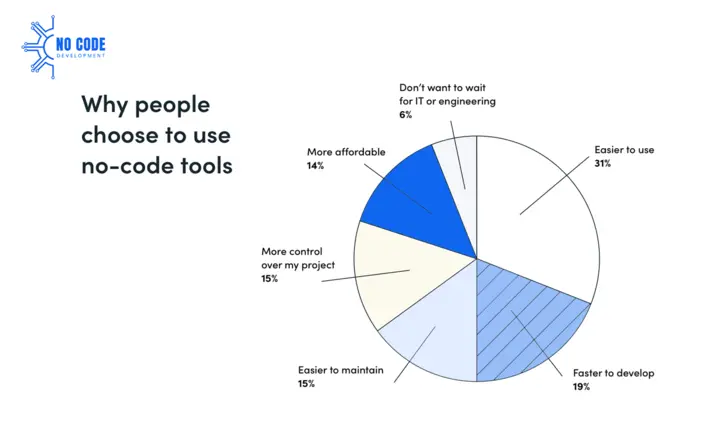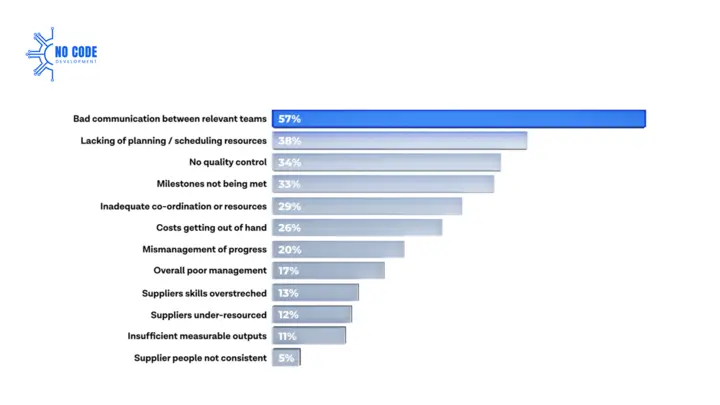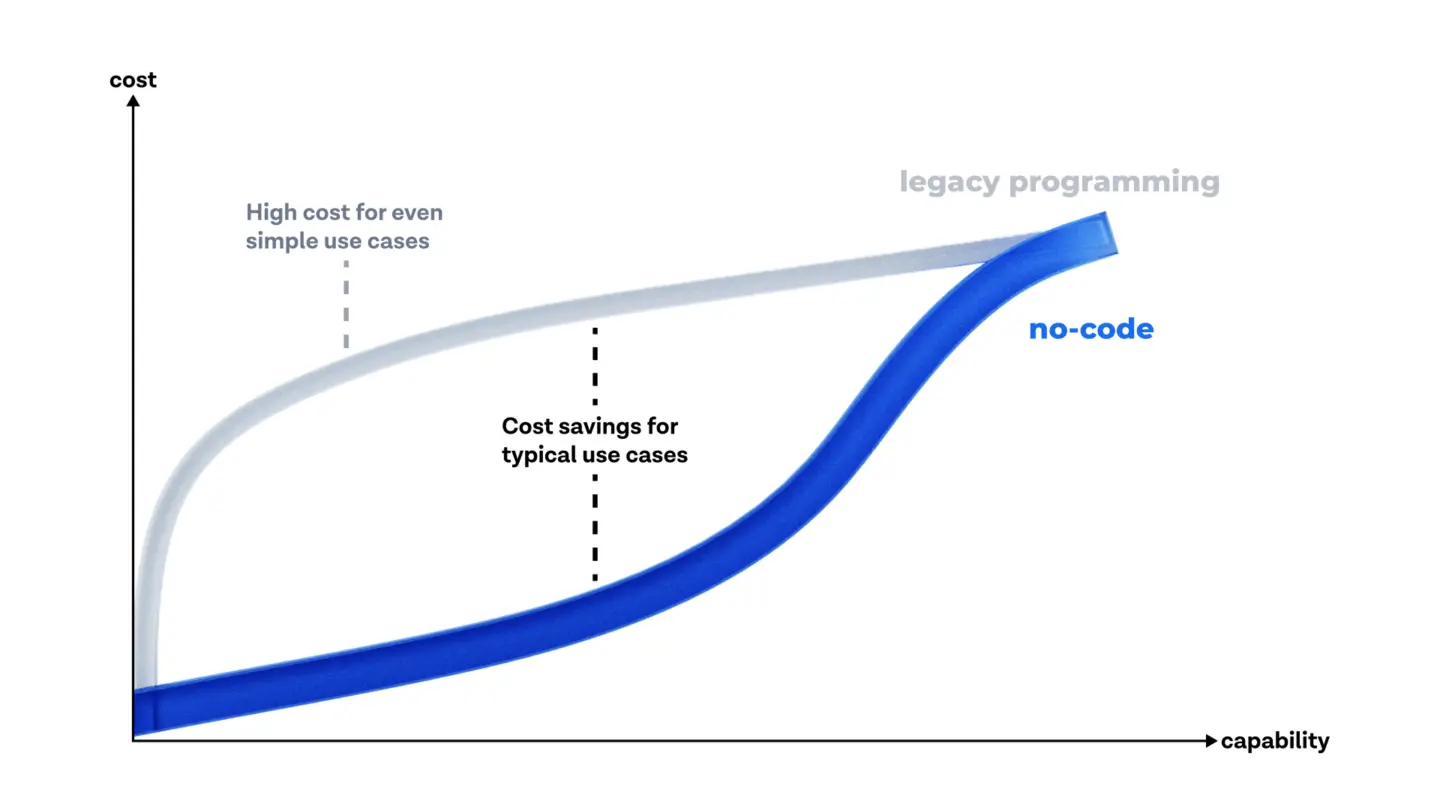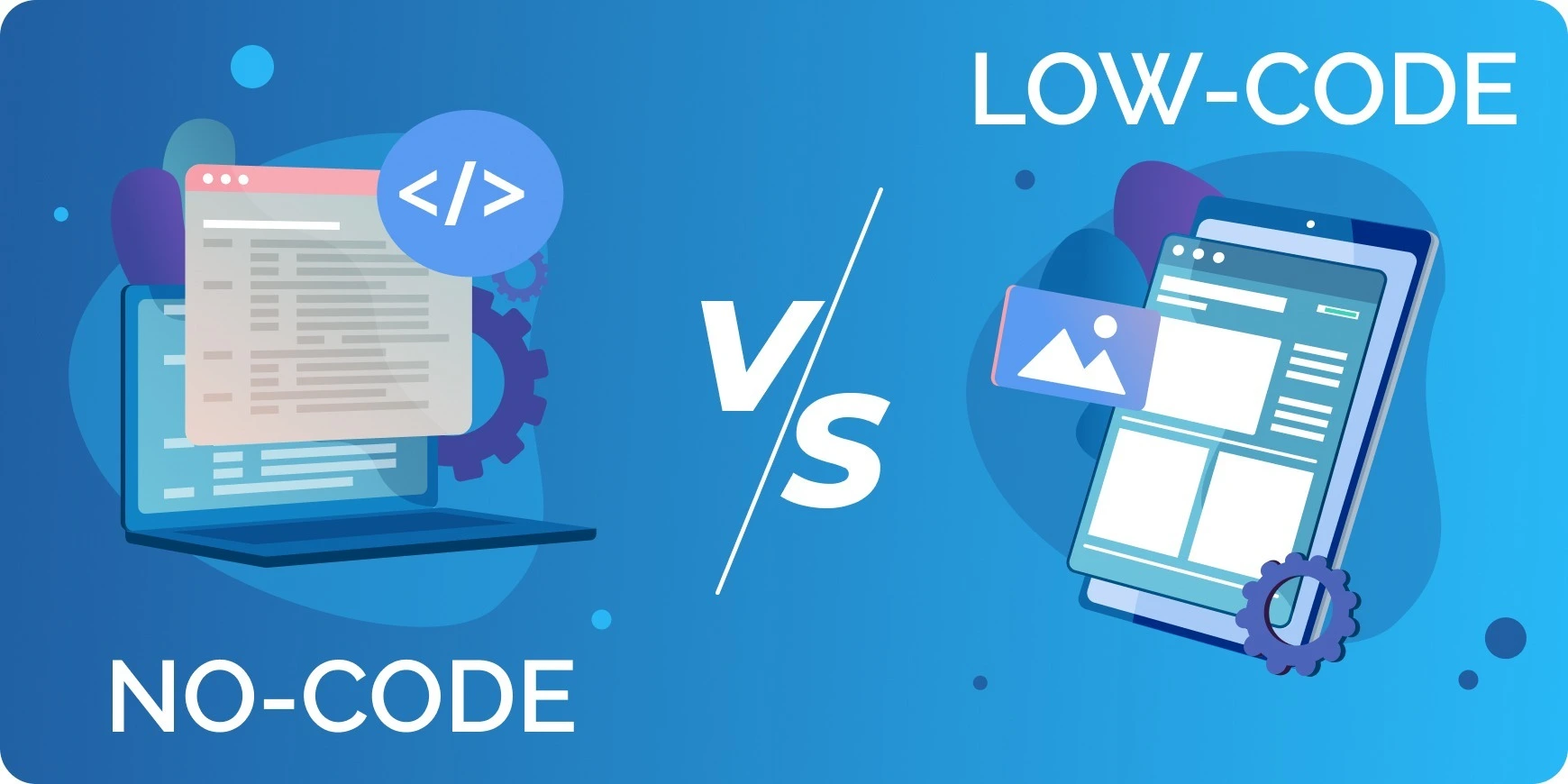Do you want to create exciting apps but need the necessary coding talent? The application development industry may appear like a secluded garden only accessible to programmers. However, don’t be afraid! No-code development is here to break through those walls and empower anyone to build.
Research shows that compared to a full-scale modernization of IT, which could take between one and two years to complete, no-code tools help save 70% of the costs, and set-up time can be as fast as three hours. It’s, therefore, not surprising that 66 percent of developers already have no code or intend to do so in the next year.
This complete guide will be your ultimate resource for understanding no-code. We will review the basic ideas, discuss the benefits of this innovative approach, and give you the skills to develop your apps – all without writing one piece of code.
What is No-Code Development?
No-code development is an approach to developing software, such as applications and websites, using visually based drag-and-drop interfaces instead of traditional coding. This method allows everyone, regardless of technical skills, to design and develop applications and the infrastructure needed for web-based applications.
When we refer to ‘build on the internet,’ we are talking about building an infrastructure for your digital creation to make your web-based concepts a reality. It could be an app or a web-based company, online gaming, an online community, or anything else you can think of.
The movement to eliminate code is based on the premise that technology must be available to everyone, not only those with special skills. Imagine a world where everyone could easily develop a mobile app, start an enterprise, or even automate their business operations. That’s what’s behind the movement to eliminate code.
Not long ago, developing apps was a job only for skilled developers or those with significant funds to employ them. If a common person thought of an app idea, it was often simply an idea, as they needed more technical expertise and resources to make it happen.
But this is fast changing due to the rise of platforms, tools, and applications, which allow anyone to create almost anything they want. This isn’t only beneficial to entrepreneurs and non-technical founders; it’s also changing the way businesses function. Today, almost all businesses utilize software in some way, making the ease of use offered by no-code tools more important.
A Brief History of No-Code Development
The story began in 1982 by Tech Savvy James Martin. In his preface for his 15th volume on the software industry Application Development without Programmers, Martin stated: “The number of programmers available per computer is shrinking so fast that most computers in the future must be put to work at least in part without programmers.” Martin accurately predicted the technology talent shortage more than 40 years ago. He also made people think about what they could accomplish if they got rid of the use of code.
The 1980s were also essential for no-code development for two additional reasons. It’s the year that the first version of Excel was launched, which many people believe was the first software that allowed users to modify data without together code. Indeed, many people who are not coders are still comparing the experience of developing using a platform that doesn’t require code to working with Excel. Additionally, this is the time when visually-based programming is beginning to gain momentum.
Why is No-Code Development Popular?
The rise of platforms with no code results from the need for operational flexibility and information availability, which are vital for business growth. Businesses must ensure the availability of their services both internally and externally to stay competitive.

Software creation using traditional coding techniques, sometimes called “legacy programming,” requires significant effort but has no benefits in the beginning stages. Starting from scratch, databases, architectures, interfaces, and integrations require substantial money from various departments, such as IT developers, software engineers, and internal users.
Communication among teams can be the biggest obstacle to the success of IT-related projects. Due to its complex technicalities, traditional code offers limited transparency for non-technical people. As long as the final product has yet to be released, the stakeholders are only aware of what it is supposed to achieve. Extra expenditures could make the development process easier; however, time and budgetary constraints can make this process difficult.
The following statistics show the major causes why IT projects don’t work.

A No-Code app builder allows non-technical users to take charge of software creation. No-code focuses on the design, which anyone can handle without coding knowledge. No-code Platforms include pre-built functions like hosting, database integrations, and certain security measures, easing the development process and decreasing the requirement for technical expertise.
Key Characteristics of No-Code Development
- Visual Development Environment (VDE): Developers design applications using drag-and-drop interfaces, visual workflows, and pre-configured components.
- Pre-built templates and Modules: No-code platforms include several designs and templates that users can adapt to their requirements.
- Integration Capabilities: Many no-code tools can use APIs to connect with other programs and services. This allows for the seamless exchange of data and automation of workflows.
- Scalability: No-code platforms can be scalable to meet the requirements of ever-growing applications, but they might have limitations compared with fully customized solutions.
What are the Benefits of No-Code Development?

1. Accessibility
Platforms that do not require code make development accessible to people with no knowledge of technology. Today, business analysts, entrepreneurs, and creative professionals can bring their ideas to fruition without relying on skilled development team members.
2. Speed
Utilizing no-code tools makes the development process much quicker. Templates and pre-built components enable users to rapidly build applications, speeding up the process from idea to implementation. This speedy development process is essential in today’s highly competitive market, where time to market can be important.
3. Cost-Effective
By removing the requirement for large teams of developers, No-code development can cut expenses. Companies can distribute resources more efficiently, focusing on important areas like marketing and customer engagement. In addition, maintenance costs are lower because the platforms manage the infrastructure and updates.
4. Flexibility
No-code platforms provide a great level of flexibility. Users can experiment with various styles and functions by making changes at a moment’s notice without worrying about complicated code. This flexibility is perfect for iterative development and constant improvement.
5. Empowerment
No-code development allows non-technical team members to be directly involved in software creation. This approach to collaboration can create more innovative solutions since diverse viewpoints are included in the development process.
Popular No-Code Tools and Platforms
1. Bubble
Bubble is a nifty No Code Application builder that allows users to create sophisticated web applications with a visually appealing interface. It has many customization options and seamlessly integrates with many third-party applications. Bubble’s robust platform can support everything from basic prototypes to production-ready applications.
2. Webflow
Webflow blends the simplicity of development without code with the capabilities of a fully-fledged design tool. It’s ideal for developing dynamic websites and e-commerce platforms without writing one line of code. Webflow’s CMS and e-commerce features make it a preferred option for marketers and designers seeking to create sophisticated online experiences.
3. Airtable
Airtable is a no-code platform that transforms spreadsheets into robust databases. It allows users to build specific workflows that can be used to manage their projects or automate work, which makes it a popular choice among teams to boost collaboration and productivity. Airtable’s versatility and simplicity allow it to be appropriate for various applications, from basic task trackers to complex systems for managing projects.
4. Zapier
Zapier streamlines the workflow by connecting various applications without the need for programming. It is an intermediary between different tools, providing seamless data exchange and task automation. With various integrations, Zapier allows users to simplify their work and boost productivity through several platforms.
5. Glide
Glide converts Excel spreadsheets to mobile applications quickly and effortlessly. Users can build functional mobile applications together with information from Google Sheets, making it an excellent choice for companies that require applications based on data structures.
6. Thunkable
Thunkable is a no-code platform specifically designed to build mobile applications. It is compatible with iOS and Android development and provides an efficient solution for developers seeking to design mobile-first experiences with no code.
Use Cases for No-Code Development
1. MVP Development
Entrepreneurs and startups can use no-code platforms to develop and test the minimum Viable Products (MVPs). This allows for speedy iterations based on user feedback, reducing the time and costs associated with traditional development methods.
2. Internal Tools
With software that does not require code, companies can create customized internal tools like CRM applications, project management systems, and HR portals. These tools can also be adapted to meet specific requirements and workflows and increase operational efficiency.
3. E-commerce Platforms
No-code options like Webflow and Shopify enable businesses to easily set up and manage online stores. They add templates that can be customized and integrated payment systems, making it easy to launch online stores.
4. Automated Workflows
Tools such as Airtable and Zapier help businesses automatize routine processes and tasks. Automated email notification to complicated Data integrations with no code, these platforms simplify operations and decrease the amount of manual work.
5. Community and Social Platforms
No-code platforms can be utilized to create forums, community portals, and social networking websites. They can also include options like user authentication, messaging, and material management with no code.
Low-Code and No-Code: What’s the difference?
While platforms that do not require code are intended for people with no programming expertise, Low-code platforms are designed for inexperienced and well-qualified developers. Low-code development requires some programming expertise and allows for greater control and customization of the application. On the contrary, no-code lets you create self-service applications without programming expertise. It lets users with expertise in the field create powerful digital applications for themselves quickly.

No-Code Platforms
- Target Users: Non-developers who don’t know about coding.
- Speed of Development: Very fast.
- Customization: Limited to certain components
- Flexibility: High for the most basic applications
Low-Code Platforms
- Target Users: Both developers and non-developers
- Speed of Development: Fast however, it requires some programming
- Customization: Very high, including the capability to create custom code
- Flexibility: Extremely high, appropriate for complex applications
Choosing Between No-Code and Low-Code
The decision between no-code and low-code depends on the project’s requirements and the team’s talent. No-code is a great choice for speedy prototyping and basic applications, as well as when programming expertise is lacking. Low code is a better choice for complex applications that need modification or integration with other software, particularly when developers are available to manage the coding aspect.
The Future of No-Code Development
The revolution in no-code technology will not fade away as advancements continue to expand the capabilities of platforms that do not require code. Since machine learning and artificial intelligence are integrated with no-code tools, the possibility of advancement is limitless. Companies increasingly adopt No Code Strategies to remain agile and competitive in an ever-changing digital world.
Trends to Watch
1. AI and Machine Learning Integration
Integrating AI and ML features will facilitate greater data analysis and automation in the no-code platform. This will enable users to develop smarter apps that analyze data, forecast trends, and automate difficult tasks without specialized expertise in these advanced technologies.
2. Increased Customization
The enhanced customization options will enable applications that do not require code to handle more intricate and specific business needs. As platforms that do not require code evolve and become more advanced, they will provide sophisticated features, giving users more control over their apps’ layout and function.
3. Expansion of Use Cases
The No-Code platforms continue broadening their uses, ranging from IoT applications to Blockchain-driven solutions. This broad range of applications will create new opportunities for companies to innovate and remain competitive in various sectors.
4. Community and Ecosystem Growth
The community of no-code developers will expand and will have greater resources, templates, and integrations available to users, encouraging collaboration and creativity. As more people adopt no-code development, the ecosystem will grow, providing various tools and assistance for creators.
5. Enterprise Adoption
As the no-code platforms grow more secure, larger companies will likely adopt them for both customer-facing and internal applications. This trend will further enhance security scalability and compliance, making no-code an attractive choice for critical applications.
6. Hybrid Development Approaches
There is a potential for a surge in hybrid development methods that blend Low Code No Code & Traditional Programming. Teams will benefit from the desirableness of both worlds together with no-code to quickly prototype and easy applications, low-code to handle intermediate complexity, and full-code to create highly custom and intricate solutions.
Final Thoughts!
No-code development is transforming how we develop applications, making them more accessible, effective, efficient, and affordable. With the abundance of tools that do not require code from anyone, anyone can bring their concepts to life, ranging from simple websites to more complex applications. As technology advances and advances, the lines between low-code and no-code will remain blurred, creating new opportunities for growth and innovation.
Whether you are an aspiring entrepreneur, a veteran developer, or have a unique idea, no-code development allows you to transform your ideas into reality. Join the movement to no-code and discover the many possibilities it provides.
Are you ready to take the next step? As a leading no-code company in the USA, we are experts in creating the best solution that doesn’t require code to make your dream come to life. Contact us today to discover the potential of development without code!

